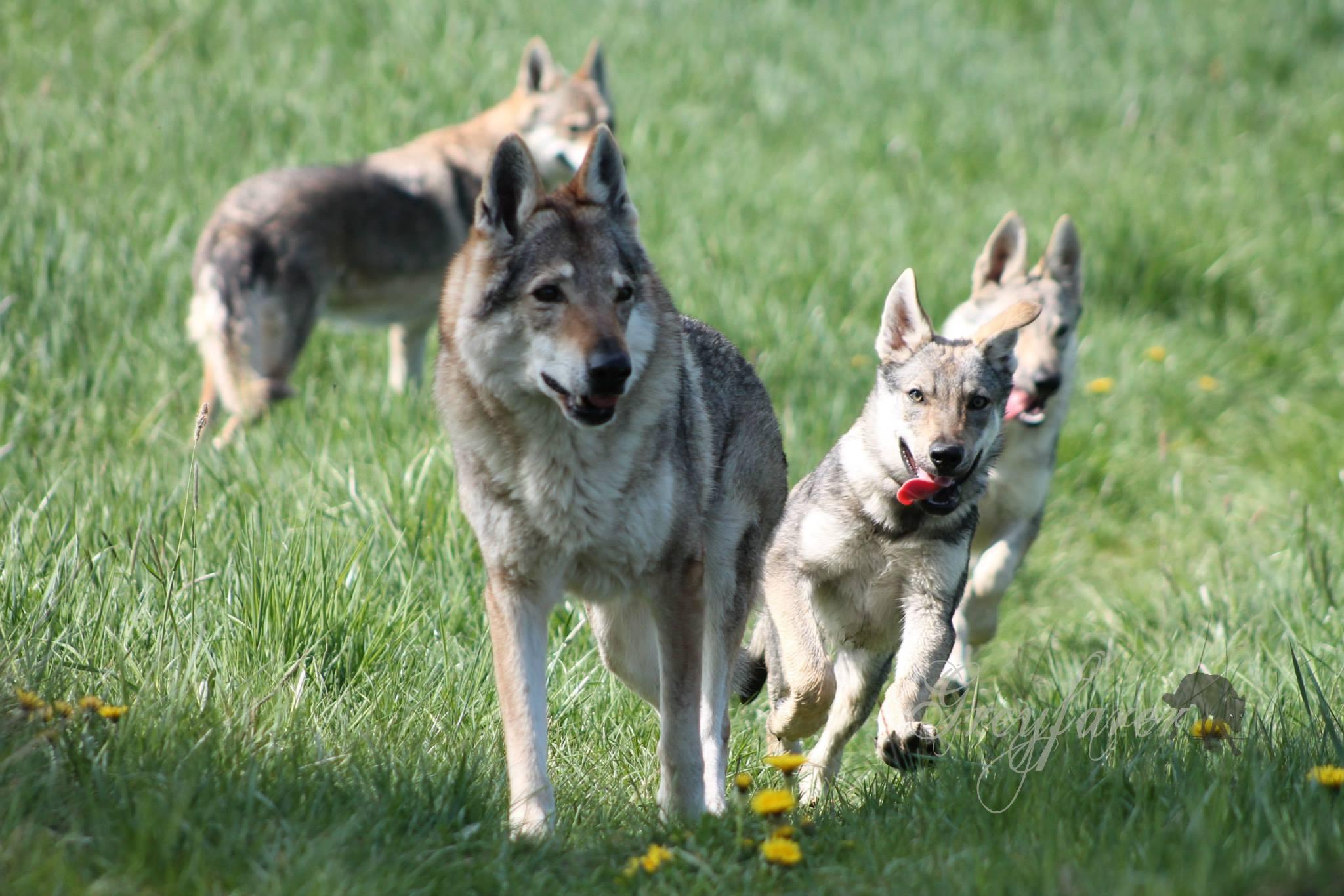Czechoslovakian Vlcaks are generally a long-lived breed. It is not uncommon to hear of individuals who are 14, 15, even 16 years old or more. Like all breeds, however, there are several breed-wide health issues.
Links to how and where to screen for these issues can be found in here.

For litters bred in the USA and Canada, we only recommend litters from parents who have been issued OFA CHIC numbers as well as OFA numbers for all applicable exams.
Degenerative Myelopathy (DM)
DM is a progressive, incurable disease that eventually robs a dog of all mobility, beginning generally with the extremities. It is a wide-spread mutation across multiple breeds and has been confirmed in German Shepherd Dogs, Boxers, and in 2015, Czechoslovakian Vlcak, among other breeds also affected. It is homozygous recessive, meaning that a dog needs to carry two copies of the gene mutation to be at-risk. Dogs who inherit just one copy of the gene mutation are simply carriers, and dogs who have no copies of the gene mutation are DM ‘clear’ or ‘normal’.
A mutation on SOD1 gene linked to the development of DM was discovered in 2008 and it is currently possible to screen a dog for their DM status so that appropriate matches can be made that will not result in any offspring being at-risk for DM. At Greyfarer, we do not agree with breeding individuals together that may result in A/A affected/at-risk puppies. Every single match must involve at least one parent who is Clear.
In late 2015, Degenerative Myelopathy was conclusively determined in Czechoslovakian Vlcak at the University of Bologna through the examination of the spinal samples donated by the owners of an Italian dog Elvyys l'Amico del Lupo upon his passing. Before this important yet unfortunate milestone, Degenerative Myelopathy was assumed to affect the breed through their genetic history with German Shepherd Dogs and through clinical observation in affected/at-risk dogs, and many CsV breeders had already been screening their dogs diligently for several years. Of the 71 mainly US-residing Czechoslovakian Vlcak screened for DM through OFA, 53.5% are clear/normal, 39.4% are carriers, and 7% are at-risk/affected (as of December 2018). These numbers are probably skewed in favor of normals/clears and carriers since mainly serious breeders and fanciers are likely to test their dogs, and their dogs probably have come from parents in combinations that would only give clear or carrier status. The prevalence of the mutation is therefore widespread in the breed on the carrier percentage alone, and breeders must take care to appropriately screen and select matches to ensure the health of their litters.
For more information on the disease and explanation of test results:

Pituitary Dwarfism (DW)
Pituitary Dwarfism is carried by about 20% of the Czechoslovakian Vlcak breed (citation: PubMed link), but it is rare to see any dwarfed Vlcak for reasons including early natural death or euthanasia. Pituitary Dwarfism is incurable although the severity of it may be lessened with medication. Dogs born with DW, depending on severity, suffer from poor coat, renal function issues, and spine formation problems. Many do not survive very long, and many more die in utero or shortly after birth. It is possible for breeders not to recognize an affected puppy if the puppy dies shortly after birth. Pituitary Dwarfism is also homozygous recessive like DM. It means that simply one just needs to screen the dogs for DW and make appropriate selections to avoid whelping any puppies that will suffer from DW. At least one parent from every match must be clear of DW.
Canine Hip Dysplasia (CHD or just "HD")
Like all large breed dogs (and increasingly confirmed in small breeds), Vlcaks can be stricken with hip dysplasia, a progressive degenerative disease of the hip joints that results in pain and possible crippling depending on severity. It is a multi-factorial and polygenetic issue, so knowledge of line health and proper screening with radiographs is paramount. I believe that PennHIP has a greater predictive value than the static OFA/FCI hip evaluation method, so optimally all the here dogs are evaluated with PennHIP with (at least) preliminary evaluation by OFA. The OFA system has roughly equivalent ratings to the international FCI system as follows:
| OFA | FCI |
| Excellent | A1 |
| Good | A2 |
| Fair | B |
| Borderline (must submit new xray) |
B2 |
| Mild Dysplasia | C |
| Moderate Dysplasia | D |
| Severe Dysplasia | E |
Hip Dysplasia is highly hereditary and has no cure.
For more information on CHD, visit the Orthopedic Foundation for Animals' Information on Canine Hip Dysplasia.
Additionally, information on understanding PennHIP values ratings can be found at AIS PennHIP.
Individual values of known evaluated CsV can also be found at Wolfdog.org - PennHIP in CsV.
A very good Question and Answer session with responses from Dr. Gail Smith who pioneered the PennHIP procedure at the University of Pennsylvania. Addresses common misconceptions, concerns, and rumors regarding PennHIP.
The current Czechoslovakian Vlcak PennHIP mean is 0.34 (provided by Antech in October 2020). It means that dogs should have hips with scores less than 0.34 (better than 50% of the tested population) to achieve breeding status, or optimally, dogs with < 0.30 bilateral. Because of the current small sample group of about 30 individuals, I rely on a combination on choosing animals with less than 0.30 values bilaterally and the traditional OFA/FCI static evaluation.
Subaortic Stenosis (SAS) and Cardiac Issues
There is growing evidence to suggest that cardiac issues exist within the breed, with cases of dogs passing away by sudden death attributed to cardiac failure. In some cases the dogs have been quite young. As there is no DNA testing available and it is very likely polygenic in nature, the best that one can do is to share information regarding one's own dog, if the dog has passed away due to cardiac-related issues (optimally in conjunction with a necropsy), screen dogs for cardiac soundness by a cardiologist via an echocardiogram especially if the dog is a breeding prospect (annual, optimally), and faithfully study the lines when considering buying or breeding a dog or bitch.
